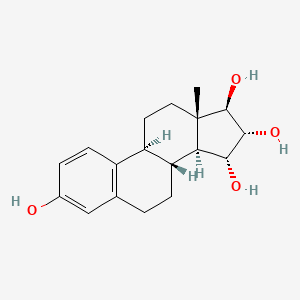



1. 15 Alpha Hydroxy Estriol
2. 15 Alpha Hydroxyestriol
3. 15 Alpha-hydroxyestriol
4. 15-alpha-hydroxy-estriol
1. 15183-37-6
2. Estetrol Anhydrous
3. 15.alpha.-hydroxyestriol
4. Enb39r14vf
5. (8r,9s,13s,14s,15r,16r,17r)-13-methyl-6,7,8,9,11,12,14,15,16,17-decahydrocyclopenta[a]phenanthrene-3,15,16,17-tetrol
6. Estetrol (usan)
7. Estetrol [usan]
8. (8r,9s,13s,14s,15r,16r,17r)-13-methyl-7,8,9,11,12,13,14,15,16,17-decahydro-6h-cyclopenta[a]phenanthrene-3,15,16,17-tetraol
9. E4
10. (14beta,15alpha,16alpha,17alpha)-estra-1,3,5(10)-triene-3,15,16,17-tetrol
11. E-4
12. Unii-enb39r14vf
13. Estell
14. Estetrolum
15. Oestetrol
16. Donesta
17. Estetrol (anhydrous)
18. 15alpha-hydroxyestriol
19. 15 Alpha-hydroxyestriol
20. Estetrol [inn]
21. Estetrol [who-dd]
22. Mls006010253
23. Schembl145580
24. Estetrol, >=98% (hplc)
25. Chembl1230314
26. Gtpl11591
27. Dtxsid50164888
28. Chebi:142773
29. Bdbm158505
30. Zinc5764481
31. Estetrol (anhydrous) [usan]
32. Who 10439
33. Akos030254521
34. At27982
35. Db12235
36. Ncgc00345819-03
37. Hy-15731
38. Smr004701329
39. Us9034854, E4
40. Cs-0008552
41. D11513
42. J-008852
43. Q5401078
44. Drovelis (ema); ; Estetrol Monohydrate + Drospirenone
45. Lydisilka (ema); ; Estetrol Monohydrate + Drospirenone
46. Nextstellis (us); Estetrol Monohydrate + Drospirenone
47. 1,3,5(10)-estratrien-3,15alpha,16alpha,17beta-tetrol
48. Estra-1(10),2,4-triene-3,15alpha,16alpha,17beta-tetrol
49. Estra-1,3,5(10)-triene-3,15alpha,16alpha,17beta-tetrol
50. 3,15alpha,16alpha,17beta-tetrahydroxyestra-1,3,5(10)-triene
51. Estra-1,3,5(10)-triene-3,15 Alpha,16alpha,17beta-tetrol
52. (15alpha,16alpha,17beta)-estra-1(10),2,4-triene-3,15,16,17-tetrol
53. Estra-1,3,5(10)-triene-3,15,16,17-tetrol, (15alpha,16alpha,17beta)-
54. Estra-1,3,5(10)-triene-3,15.alpha.,16.alpha.,17.beta.-tetrol
55. Estra-1,3,5(10)-triene-3,15,16,17-tetrol, (15.alpha.,16.alpha.,17.beta.)-
56. 4oh
| Molecular Weight | 304.4 g/mol |
|---|---|
| Molecular Formula | C18H24O4 |
| XLogP3 | 1.5 |
| Hydrogen Bond Donor Count | 4 |
| Hydrogen Bond Acceptor Count | 4 |
| Rotatable Bond Count | 0 |
| Exact Mass | 304.16745924 g/mol |
| Monoisotopic Mass | 304.16745924 g/mol |
| Topological Polar Surface Area | 80.9 Ų |
| Heavy Atom Count | 22 |
| Formal Charge | 0 |
| Complexity | 441 |
| Isotope Atom Count | 0 |
| Defined Atom Stereocenter Count | 7 |
| Undefined Atom Stereocenter Count | 0 |
| Defined Bond Stereocenter Count | 0 |
| Undefined Bond Stereocenter Count | 0 |
| Covalently Bonded Unit Count | 1 |
Estetrol is indicated in combination with drospirenone for the prevention of pregnancy.
Estetrol prevents pregnancy by suppressing ovulation.
Absorption
Estetrol is rapidly absorbed from the gastrointestinal tract. The Cmax of estetrol is 18 ng/mL according to the results of a pharmacokinetic study, with an AUC of 36.4 ngh/mL. When estetrol and drospirenone are taken in a single product, maximum serum concentrations of approximately 48.7 ng/mL are achieved within 1-3 h. Bioavailability of the combination ranges between 76 and 85%. The Tmax can range from 0.5 to 2 hours and time to steady state is approximately 4 days, according to the results of one clinical study.
Route of Elimination
Estrogens are generally excreted as sulfated and glucuronidated derivatives. Approximately 69% of a dose of estetrol is excreted in the urine, and about 22% is excreted in the feces as unchanged drug.
Volume of Distribution
Limited distribution of estetrol into red blood cells has been demonstrated.
Estretol is heavily metabolized after oral administration. Phase 2 metabolism of estrogen forms glucuronide and sulfate conjugates with negligible in-vitro estrogenic activity. In vitro metabolism studies demonstrate that UGT2B7 catalyzes the formation of E4-16-glucuronide. Estetrol is combined with [drospirenone] in a product. The hepatic cytochrome enzyme CYP3A4 metabolizes drospirenone to two primary metabolites: the acid form of drospirenone through the opening of the lactone ring and the 4,5 dihydrodrospirenone formed by reduction, followed by sulfation. Both metabolites are pharmacologically inactive.
The elimination half-life of estetrol is approximately 27 hours. Half-life may range between 19-40 hours.
Estetrol is a synthetic analogue of a naturally occurring estrogen present during pregnancy, demonstrating selectivity for both estrogen receptor- (ER-) and ER- and suppressing ovulation. Estetrol binds with a low to moderate affinity human estrogen receptor alpha (ER alpha) and ER beta with a preference for ER alpha. Estetrol demonstrates a unique mechanism of action via tissue selective activity, showing estrogen receptor agonist activity on the vagina, the uterus and the endometrium, and negative estrogenic activity on breast tissue.